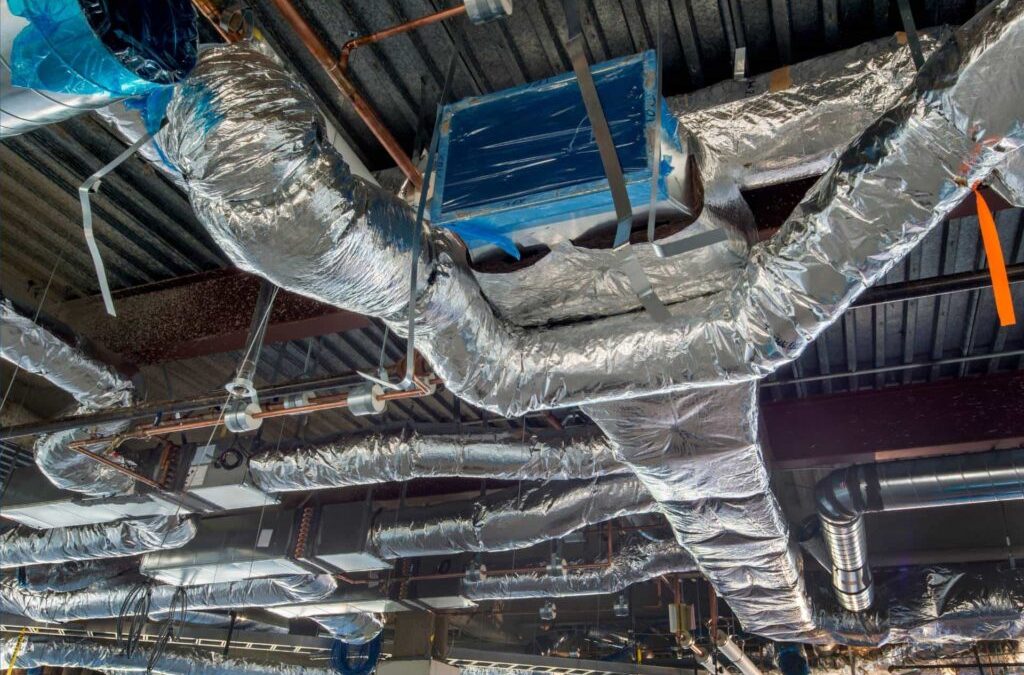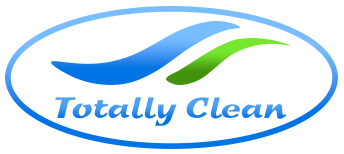Answered! What is Duct Sealing?

Many people face a common problem in their homes: they notice that their heating and cooling systems don’t work as well as they should. This issue can make homes less comfortable and lead to higher energy bills.
Duct sealing is a solution to this problem. Sealing leaks in ductwork helps the HVAC system distribute air more efficiently throughout a house.
Duct sealing can help reduce a home’s energy usage by up to 20%. This process involves finding and fixing any duct leakage in the air paths that carry air from your furnace or air conditioner into your rooms.
The article will guide homeowners through the duct sealing process, including its benefits, how it’s done, and how to choose the right professional for the job. Keep reading to learn how sealing your ducts can make your home more energy efficient and improve indoor air quality.
Key Takeaways
- Duct sealing eliminates air duct leaks, increasing HVAC efficiency by up to 20% and reducing energy costs while enhancing indoor comfort.
- It provides comprehensive coverage and uses safe materials like mastic sealant or foil tape and advanced methods, such as Aeroseal technology.
- Sealed ducts also improve indoor air quality by preventing pollutants and allergens from circulating in the home.
- Hiring a qualified professional is crucial for effective duct sealing. Look for contractors with proper licenses, experience, and knowledge of energy conservation.
- The process contributes significantly to environmental protection by reducing household energy consumption and carbon footprint.

What Is Duct Sealing?
Duct sealing refers to the process of making air passages leak-proof. By preventing air loss, duct sealing increases the efficiency of heating, cooling, and ventilation systems. By sealing leaks in the ductwork, homeowners can ensure their HVAC system operates at maximum efficiency, reducing energy bills and maintaining a comfortable home environment.
This procedure has two main objectives: First, it reduces energy consumption by up to 20%, and second, it prevents pollutants from infiltrating the ducts and spreading throughout a home, thus improving indoor air quality. To achieve these benefits, visible and hidden ductwork leaks must be addressed.
This involves using specific materials, like mastic sealant or foil tape, on areas such as the supply plenum, its connection to the furnace or air handler, and other critical parts of the HVAC system.
Securing these components enhances energy efficiency for heating and cooling. Professionals use duct sealant materials that are safe, non-toxic, and low in volatile organic compounds (VOCs), ensuring they are safe for household use. By thoroughly sealing all HVAC system joints where conditioned air circulates, homeowners can save money, enjoy cleaner air, and experience better temperature management.
Role in HVAC System Efficiency
Sealing air ducts is important for improving HVAC system efficiency. According to Energy Star, Leaks in ductwork can cause homes and buildings to lose up to 20% of their heated or cooled air, forcing air conditioners, furnaces, and dehumidifiers to work harder than necessary. By sealing these leaks, HVAC systems consume less energy to maintain the desired temperature, which helps them operate more efficiently and last longer.
This increased efficiency extends the lifespan of heating and cooling systems. It leads to lower utility bills, requiring less energy to keep homes comfortable. Moreover, sealed ducts prevent back-drafting, which can otherwise allow harmful combustion gases from appliances like water heaters and clothes dryers to enter living spaces.
Comprehensive duct sealing enhances indoor air quality by preventing pollutants and allergens from entering the HVAC system. This creates a healthier living environment, free from dust and other particles that can negatively impact health.

Advantages of Duct Sealing
Duct sealing offers significant benefits by improving indoor air quality and reducing energy waste. By preventing leaks in your HVAC system, duct sealing helps keep conditioned air from escaping, making heating, ventilation, and air conditioning systems more effective and efficient.
Read our in-depth and complete article on the benefits of duct sealing here.
Promote Better Indoor Air Quality
Sealing ducts play a vital role in enhancing the air quality inside your home. By stopping leaks, duct sealing prevents dust, allergens, and pollutants from entering the HVAC system and spreading throughout the house. This can lead to a healthier living environment by reducing exposure to harmful particles that can cause allergies, asthma, and other respiratory problems. Additionally, duct sealing helps prevent dangerous gases, such as carbon monoxide, from leaking into living spaces, further safeguarding your family’s health.
Boost Energy Efficiency
Duct sealing is critical to improving energy efficiency in homes. Leaks in the ductwork can cause up to 20% of heated or cooled air to be lost, forcing your HVAC system to work harder to maintain the desired temperature. By sealing these leaks, you ensure the system runs more efficiently, reducing the energy needed to heat or cool your home. This makes your home more comfortable and extends the lifespan of your HVAC equipment by reducing wear and tear.
Reduce Energy Costs
One of the most noticeable benefits of duct sealing is the reduction in energy costs. With sealed ducts, less conditioned air escapes, meaning your heating and cooling systems use less energy to achieve the same comfort level. This translates to lower utility bills and significant savings over time. Using methods like mastic sealant, foil tape, or advanced techniques such as Aeroseal technology ensures a thorough sealing process, maximizing energy efficiency and reducing costs.
Choose the Right Professional
Selecting the right professional for duct sealing is essential to achieve the best results. Experienced contractors can accurately identify and seal leaks using suitable materials and techniques. A professional will assess the entire HVAC system, including supply plenums and connections to furnaces or air handlers, to ensure that all leaks are effectively sealed. By hiring a qualified contractor, homeowners can enjoy improved comfort, lower energy bills, and enhanced system performance.

Techniques for Sealing Ducts
Experts use various duct sealing methods to improve HVAC efficiency and prevent air loss. Standard techniques include applying mastic sealant, using foil tape, and employing advanced Aeroseal technology. Each method targets leaks to enhance the overall performance of heating and cooling systems.
Apply Mastic Sealant
Mastic sealant is a thick, sticky substance applied to seal leaks in ductwork. Using a caulk gun, professionals spread mastic on the joints and seams of ducts, ensuring that all leaks are covered. This method is effective for visible and hidden leaks, making it a versatile solution for air sealing.
Mastic is non-toxic, safe for household use, and helps improve energy efficiency by stopping air from escaping the ducts. When applied correctly, mastic seals the ducts and prevents pollutants from entering the system, enhancing indoor air quality. For optimal results, the application must be thorough, covering all leaks without obstructing airflow inside the ducts.
Use Foil Tape
Foil tape is another popular method for sealing ductwork. This particular tape is designed to adhere tightly to the surface of ducts, creating an airtight seal. It is commonly used for sealing joints and seams in heating and air conditioning systems.
Homeowners often prefer foil tape because it is easy to use and highly effective. It is durable and resistant to temperature changes, ensuring that the seals remain intact. To apply foil tape, the duct surface needs to be cleaned first, and then the tape is carefully placed over any gaps or holes.
This method is excellent for tackling minor leaks without requiring specialized tools or skills. By preventing air loss, foil tape helps reduce energy usage by up to 20%, leading to lower energy bills and improved indoor air quality.
Implement Professional Aeroseal Technology
Aeroseal technology is an advanced method for sealing ducts, ideal for property owners who want a comprehensive solution. This technique involves injecting a safe, non-toxic sealant into the ductwork. The sealant particles travel through the ducts and seal leaks from the inside, reaching areas that traditional methods might miss.
Aeroseal is UL-listed and low in volatile organic compounds (VOCs), making it safe for homeowners and the environment. The process begins with a thorough inspection by trained professionals to locate leaks. They then use specialized equipment to apply the Aeroseal compound, effectively sealing visible and hidden leaks.
Research shows that Aeroseal can reduce energy consumption by up to 20%, making it a powerful tool for increasing HVAC efficiency. It helps maintain consistent temperatures, improves humidity control, and enhances indoor air quality by keeping pollutants out. Aeroseal offers a non-invasive, efficient solution that significantly saves heating and cooling costs with minimal disruption to daily routines.

Choosing a Duct Sealing Professional
Selecting the right technician for duct sealing involves checking their credentials and ensuring they have a strong history of accurately assessing homes.
Learn More: How much does duct sealing cost?
Criteria for Selecting a Contractor
Selecting the appropriate duct sealing contractor is crucial for homeowners. The decision can drastically influence a home’s energy conservation and indoor air clarity. Here are vital standards for assessment:
- Verify Licenses and Certifications: Ensure the contractor has all essential licenses and credentials from respected industry bodies, indicating compliance with fundamental prerequisites for duct sealing.
- Seek Proven Experience in Duct Sealing: Contract someone with a well-established history in duct sealing. Seasoned contractors would know how to secure both observable and hidden leaks effectively.
- Enquire About Their Assessment Routine: A competent contractor scrutinizes your HVAC structure. They inspect the supply plenum, its connection to the air handler or furnace, and the stove.
- Confirm the Use of Secure Sealants: The materials employed should be harmless, low-VOC certified, and UL-listed. Safety is crucial concerning elements circulating in your home’s air.
- Evaluate Their Stance on Energy Conservation: The contractor should illustrate how their work will increase appliance efficiency. Proper duct sealing can decrease a home’s energy consumption by up to 20%.
- Inspect their Former Projects: Request for references or case studies where they have effectively enhanced air clarity and decreased energy expenses through duct sealing.
- Gauge their Understanding of Air Clarity Enhancement: The optimal contractor realizes that superior sealed ducts improve indoor air quality by stopping pollutants from circulating.
- Ask About Warranty and Post-Completion Support: Verify if they provide any warranty on their work quality and the type of after-service they offer upon job completion.
Through meticulous examination of potential contractors based on these standards, homeowners can ensure that they select a professional skilled in improving their home’s comfort, safety, and efficiency via specialized duct sealing tactics.

Importance of Expert Evaluation
Hiring the right professional for duct sealing is essential for homeowners looking to improve their HVAC system’s efficiency and air quality. Trained experts have the skills and knowledge to detect visible and hidden leaks within air duct systems, ensuring a comprehensive sealing process.
These professionals use specialized tools to accurately apply mastic sealant or foil tape, targeting specific leaks and gaps. They can also employ advanced methods like Aeroseal technology, which seals leaks from the inside, reaching areas that traditional methods might miss.
An expert evaluation involves more than just applying sealants. It includes thoroughly inspecting all components, such as supply plenums and their connections to air handlers or furnaces. Professionals understand how different parts of a home, like crawl spaces, basements, and attics, interact with the HVAC system. This knowledge helps them address all potential problem areas effectively.
Homeowners can ensure their HVAC system operates at peak efficiency by choosing a qualified contractor. Proper duct sealing can reduce energy usage by up to 20%, resulting in lower energy bills and a more comfortable living environment, especially during extreme weather conditions.
Moreover, professionals are trained to use safe, non-toxic materials low in volatile organic compounds (VOCs) and UL-listed, ensuring safety and health standards are met. Their expertise also contributes to better indoor air quality by preventing pollutants from circulating through the home, reducing the risks associated with poor air quality and environmental pollutants.
Conclusion
Duct sealing is an essential measure for homeowners seeking to improve their homes. It enhances the efficiency of heating, ventilation, and air conditioning systems and fosters healthier indoor air by reducing pollutants.
Choosing this solution allows families to experience cleaner air and stabilizes temperatures across their homes. It also serves as an effective method to reduce energy expenses. Homeowners prioritizing duct sealing can feel confident in their economic decisions, which benefits their finances and the environment.
FAQs
What is duct sealing?
Duct sealing improves the efficiency of your air conditioning system by reducing leaks in your ductwork.
How does duct sealing affect my thermostat?
Proper duct sealing can give you more accurate readings from your thermostat since less heat will be lost or gained through leaky air-conditioned spaces.
Can I monitor the effects of duct sealing with an SMS alert system?
Yes, specific systems can send SMS updates regarding changes to temperature and energy consumption after implementing duct sealing.
Why should I consider getting my home’s air conditioning ducts sealed?
Duct sealing helps maintain a comfortable indoor temperature. It reduces energy waste, leading to lower utility bills over time.




